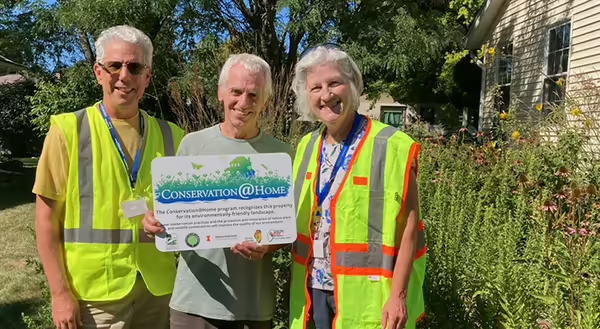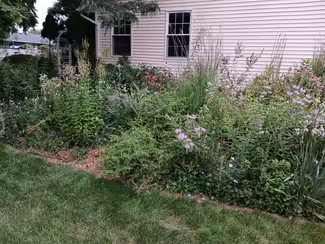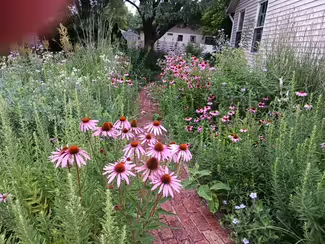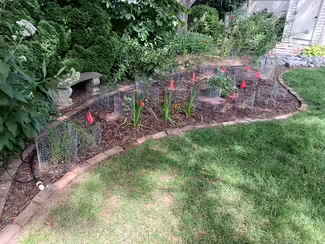
By Mike McGraw, Extension Master Naturalist serving Fulton, Mason, Peoria, and Tazewell counties
In September, 2023, my wife and I were honored to have our yard certified as eco-friendly by the Conservation@Home program. It has been a 29-year journey from “nothing” to a small haven for birds, insects and native plants.
When we moved into our Washington, Illinois home in 1995, it was new construction. The yard was bare – no grass, not a single bit of green anywhere.My wife and I both loved flowers and wanted a well-landscaped yard, so we immediately set about planting a lawn, trees, shrubs, and flower beds. However, at that time we were not yet aware of the benefits of native landscaping. We planted mostly standard garden fare: grass, lilacs, roses, peonies, and daylilies,
Almost immediately, I built a large double-bin compost box, and we added feeders and a water source to attract birds. At some point, we realized our somewhat typical suburban yard required a lot of work: watering, weeding, fertilizing, and mowing. The benefits of less grass and native prairie plants began to appeal to us.
At first, we started with just a few natives. We were intrigued by Switchgrass, Sideoats Grama, Ironweed, Common Milkweed and the majestic Compass Plant.
We felt a connection to Illinois’ prairie past. Once we noticed how many bees, wasps and butterflies were attracted to our yard, we knew natives were the way to go. Slowly, little by little, we replaced many of our exotic plantings with indigenous plants. New beds were planted mostly with natives as well.
Today, we still have some grassy lawn, as well as boxwoods, irises, lilacs, peonies and hostas. They fit in nicely with our mostly semi-wild landscape. About half of our yard is devoted to beds of various kinds, including several sunny “prairie” beds; a garden in the shade of two Hawthorn trees; and the newest addition, a rain garden.
The prairie beds are packed with more than 40 species of mostly-native plants and grasses, from the commonplace, such as Purple Coneflower and Bee Balm, to the uncommon: Round-headed Bush Clover and Eastern Agave. The shade garden boasts Zigzag Goldenrod, Wild Geranium, Wild Ginger, Large-flowered Bellwort, and even Mayapple and a Jack-in-the-pulpit. Native plants, including Button Bush, Swamp Mallow and Cardinal Flower, also populate the rain garden.
Once we had a landscape with mostly native plants, other conservation practices just made good sense. Pesticides are no longer necessary, as most native plants are rarely bothered by pests. And using pesticides might harm the bees and butterflies that we are trying to attract. Little watering is necessary as most Illinois natives are little bothered by periods of drought. And we still have a compost box.
We added bee houses to provide a home for the solitary bees. To aid all the “good” insects, we don’t cut back our plants in the fall, creating an overwintering haven for them.
We like the birds that are attracted to our yard. Eleven trees and a few shrubs provide food and shelter, feeders are kept filled all winter long, and a bird bath provides water.
Twenty-nine years ago, we hoped to enjoy our outdoor space. Today, our yard brings us great joy. We love to see Goldfinches feasting on Coneflower seeds in the winter, to watch the many Bumble Bees circling the Culver’s Root, to catch a glimpse of a hummingbird sipping nectar from Royal Catchfly. Brilliant Northern Cardinals splash in the bird bath, and perfectly peaceful wasps feed on Rattlesnake Master. It was a long journey and much work from nothing to Conservation@Home, but it was well worth it.



